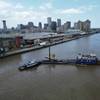UK P&I Club’s ‘Legal Briefing’ Focusses on BW Management
The UK P&I Club has chosen to focus its latest Legal Briefing publication on the International Convention for the Control and Management of Ships’ Ballast Water and Sediments, adopted by the IMO in 2004. Implementation of the Convention is now probably just two years away and ship owners and managers are coming under increasing pressure as they struggle to be ready in time.
Over the past 20 to 30 years, the consequences of Invasive Alien Species (IAS) travelling around the globe in ships’ ballast water have become increasingly apparent. Fisheries are being damaged, river banks are being eroded and power stations are spending millions of dollars keeping their water intakes clear. Global pressure persuaded the IMO to act and this 2004 Convention was the result.
The Convention will come into force one year after 30 states, representing 35 per cent of the world’s tonnage, sign up without reservation or have ratified it. So far 27 countries representing just over 25 per cent of the world’s tonnage have done so. It is impossible to know for certain how much longer it will take to reach the target of 30 states/35 per cent of the tonnage because to become a signatory, each government must find time in its own legislative process to address this subject. However, with outstanding states such as Panama having already enacted national legislation and the EU likely to urge its members to act,
developments could be rapid.
Jacqueline Tan, UK Club senior claims executive and author of the Legal Briefing, warned:
“The ratification of the Convention and unilateral adoption of ballast water regulations in other countries means the time available for adopting the operational and documentary procedures is diminishing quickly.
“It could place shipowners and crews under considerable pressure to achieve compliance let alone get to grips with the operational complexities of ballast water regulations.”
Standards to be applied and shipowners’ responsibilities
The Convention recognises that ships differ in type, size and configuration and so initially allows for two standards of ballast water management: the Ballast Water Exchange Standard (BWE) – which is only acceptable until January 2014 or 2016 depending on the ballast capacity of the ship - and the Ballast Water Performance Standard (BWP) where ballast water must be treated prior to discharge. Details of both standards and the relevant methods for conducting ballast water exchange are outlined in the UK P&I Club’s Legal Briefing.
In order to check and assist with compliance to the afore mentioned regulations, the Convention imposes strict requirements in relation to documents that should be on board the ship at all times. These are a Ballast Water Management Plan specific to each ship, a Ballast Water Record Book, which may be in the form of an electronic record system or integrated into another record book or system, and an International Ballast Water Management Certificate. This certificate may be issued by the flag state or by surveyors or organisations nominated by the flag state.
The Convention allows Port State Control officers to board the ship to check that the ship has on board a valid certificate, to inspect the Ballast Water Record Book and to take a sample of the ship’s ballast water. Should any concerns come to light during an inspection, a more detailed inspection may be carried out but all efforts should be made to avoid undue delay to the movement or the departure of the ship.
Timetables, sanctions and allowed exceptions
The Legal Briefing also gives details of the timetable for compliance and the sanctions that apply in case of non-compliance or violations. Sanctions are established under the law of the flag state for the ship concerned and these sanctions will be applicable wherever the violation occurs.
There are of course times when exceptions have to be made such as when a ship finds herself in an emergency situation or there is an accidental discharge despite all reasonable precautions having been taken. Ships are also allowed to discharge untreated ballast water if the discharge location is the same as where it was taken onboard.
Time is running out
There are many things a shipowner needs to do before the Convention comes into force and some are now becoming really urgent says the UK P&I Club. For example, a shipowner needs to conduct a study of all ballast water treatment systems available. Modifying or installing a ballast water treatment system is very costly and the Club warns that many uncertainties are making the choice of a suitable system extremely difficult. Furthermore there are not enough installation facilities to cope with the necessary work and a first-come, first-served system would not favour indecisive owners.
There is now, the Club believes, a sufficient choice of equipment for ships with ballast capacities below 5,000 m3 but this is still not the case for ships with ballast capacities above 5,000 m3. To make matters worse, new systems submitted for approval are not being approved sufficiently quickly, thus limiting choice.
Recent US legislation has further added to the confusion. The current New York State ruling requires a performance standard up to 1,000 times more stringent than the BWP standard in the Ballast Convention. There is however at present no known equipment capable of meeting this standard.
The owner then needs to devise a Ballast Water Management Plan and have it approved by the ship’s classification society. The classification society, if authorised by the flag state to do so, will then issue the ship with a complying certificate. When this is completed, all crew members and staff who will be involved in operating the ballast water management system onboard the ship must be properly trained to do so.
It can be seen that the time frame involved is not easily reduced in length.
Background to Invasive Alien Species (IAS)
The transfer of Invasive Alien Species (IAS) by ships has been a known problem for centuries. In the days of wooden sailing ships, IAS would travel the world hidden in holes that had been bored into the hull planking or in the layers of weed that were common on ships’ hulls – wood and steel alike - until just a few decades ago. Only when modern biocides were applied to hulls did this aspect of the problem diminish but by then, IAS had established other ways of travelling the globe, most notably in ballast water.
Ballast has always played a role in the transfer of IAS, notably plant species in the days when ballast consisted of solid bulk materials. Roughly speaking, the migration of marine organisms and crustaceans really took off with the widespread adoption of water ballast tanks in the 1950s/60s and the growth of ship sizes in the 1980s onwards.
Once established, IAS can have a massive negative effect on local environments. No doubt because of its size and the fact that it is edible, the Chinese mitten crab (Eriocheir sinensis) is perhaps best known but the North American Comb Jellyfish (Mnemiopsis leidyi) and Northern Pacific Seastar (Asterias amurensis) are just two other species that cause serious headaches for the human populations that live alongside their newly adopted habitats.
All three interfere with commercial and private fishing activities while the mitten crab is also well-known for damaging river banks even in urban areas. The North American Comb Jellyfish wreaks havoc by feeding heavily on zooplankton and has contributed significantly to the collapse of fisheries in the Black and Azov Seas while the North Pacific Seastar has arrived in Southern Australia to feed on shellfish including commercially valuable scallop, oyster and clam species.
Another traveller in ballast water is the Zebra Mussel (Dreissena polymorpha). Originally from freshwater lakes in Russia, it is believed to have arrived in North America via the Great Lakes. According to the Center for Invasive Species Research at the University of California, Riverside, it costs the US over $500 million per annum as it has further migrated to other lakes where build-ups of mussels restrict water flows into power stations and other water-dependent facilities.
Source: UK P&I











